wheel size SAAB 9-5 2009 Owners Manual
[x] Cancel search | Manufacturer: SAAB, Model Year: 2009, Model line: 9-5, Model: SAAB 9-5 2009Pages: 272, PDF Size: 21.53 MB
Page 222 of 272
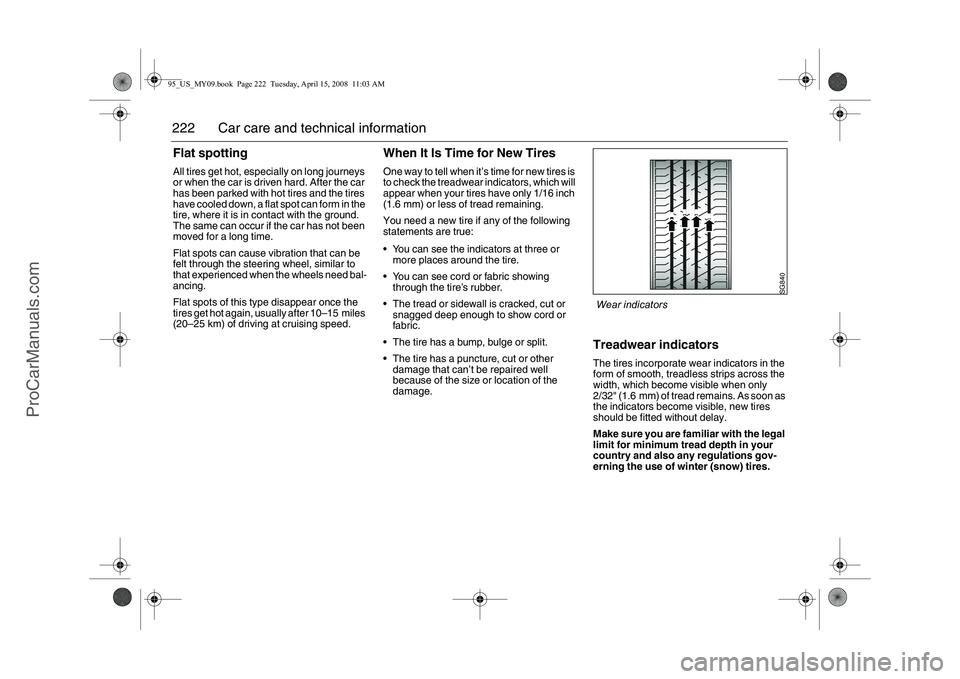
222 Car care and technical informationFlat spottingAll tires get hot, especially on long journeys
or when the car is driven hard. After the car
has been parked with hot tires and the tires
have cooled down, a flat spot can form in the
tire, where it is in contact with the ground.
The same can occur if the car has not been
moved for a long time.
Flat spots can cause vibration that can be
felt through the steering wheel, similar to
that experienced when the wheels need bal-
ancing.
Flat spots of this type disappear once the
tires get hot again, usually after 10–15 miles
(20–25 km) of driving at cruising speed.
When It Is Time for New TiresOne way to tell when it’s time for new tires is
to check the treadwear indicators, which will
appear when your tires have only 1/16 inch
(1.6 mm) or less of tread remaining.
You need a new tire if any of the following
statements are true:
You can see the indicators at three or
more places around the tire.
You can see cord or fabric showing
through the tire’s rubber.
The tread or sidewall is cracked, cut or
snagged deep enough to show cord or
fabric.
The tire has a bump, bulge or split.
The tire has a puncture, cut or other
damage that can’t be repaired well
because of the size or location of the
damage.
Treadwear indicatorsThe tires incorporate wear indicators in the
form of smooth, treadless strips across the
width, which become visible when only
2/32" (1.6 mm) of tread remains. As soon as
the indicators become visible, new tires
should be fitted without delay.
Make sure you are familiar with the legal
limit for minimum tread depth in your
country and also any regulations gov-
erning the use of winter (snow) tires.
SG840
Wear indicators
95_US_MY09.book Page 222 Tuesday, April 15, 2008 11:03 AM
ProCarManuals.com
Page 223 of 272
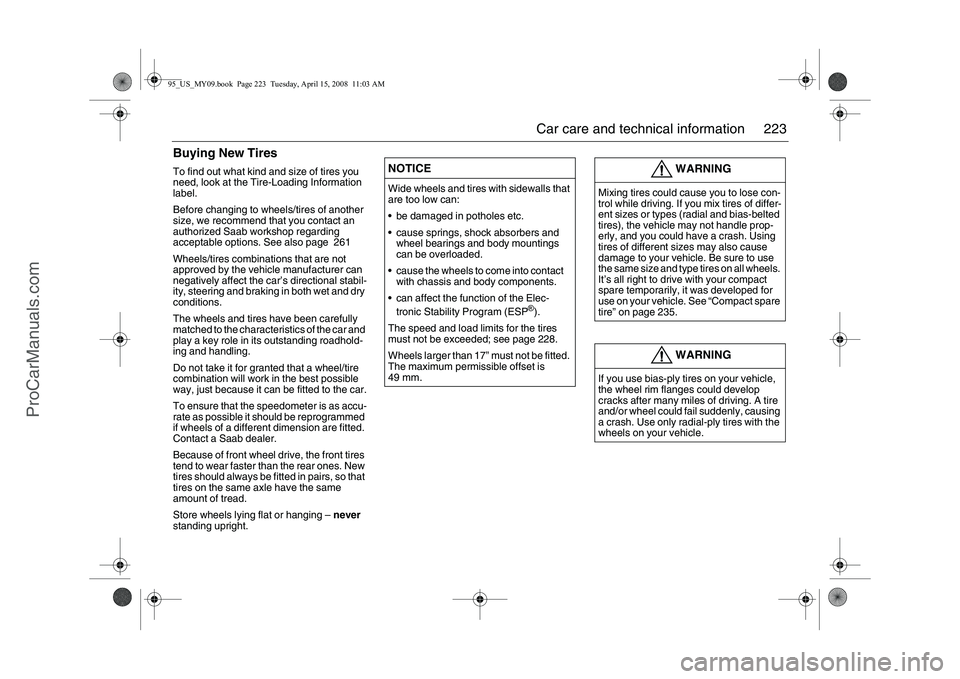
223 Car care and technical information
Buying New TiresTo find out what kind and size of tires you
need, look at the Tire-Loading Information
label.
Before changing to wheels/tires of another
size, we recommend that you contact an
authorized Saab workshop regarding
acceptable options. See also page 261
Wheels/tires combinations that are not
approved by the vehicle manufacturer can
negatively affect the car’s directional stabil-
ity, steering and braking in both wet and dry
conditions.
The wheels and tires have been carefully
matched to the characteristics of the car and
play a key role in its outstanding roadhold-
ing and handling.
Do not take it for granted that a wheel/tire
combination will work in the best possible
way, just because it can be fitted to the car.
To ensure that the speedometer is as accu-
rate as possible it should be reprogrammed
if wheels of a different dimension are fitted.
Contact a Saab dealer.
Because of front wheel drive, the front tires
tend to wear faster than the rear ones. New
tires should always be fitted in pairs, so that
tires on the same axle have the same
amount of tread.
Store wheels lying flat or hanging – never
standing upright.
NOTICEWide wheels and tires with sidewalls that
are too low can:
be damaged in potholes etc.
cause springs, shock absorbers and
wheel bearings and body mountings
can be overloaded.
cause the wheels to come into contact
with chassis and body components.
can affect the function of the Elec-
tronic Stability Program (ESP
®).
The speed and load limits for the tires
must not be exceeded; see page 228.
Wheels larger than 17” must not be fitted.
The maximum permissible offset is
49 mm.
WARNING
Mixing tires could cause you to lose con-
trol while driving. If you mix tires of differ-
ent sizes or types (radial and bias-belted
tires), the vehicle may not handle prop-
erly, and you could have a crash. Using
tires of different sizes may also cause
damage to your vehicle. Be sure to use
the same size and type tires on all wheels.
It’s all right to drive with your compact
spare temporarily, it was developed for
use on your vehicle. See “Compact spare
tire” on page 235.
WARNING
If you use bias-ply tires on your vehicle,
the wheel rim flanges could develop
cracks after many miles of driving. A tire
and/or wheel could fail suddenly, causing
a crash. Use only radial-ply tires with the
wheels on your vehicle.
95_US_MY09.book Page 223 Tuesday, April 15, 2008 11:03 AM
ProCarManuals.com
Page 226 of 272
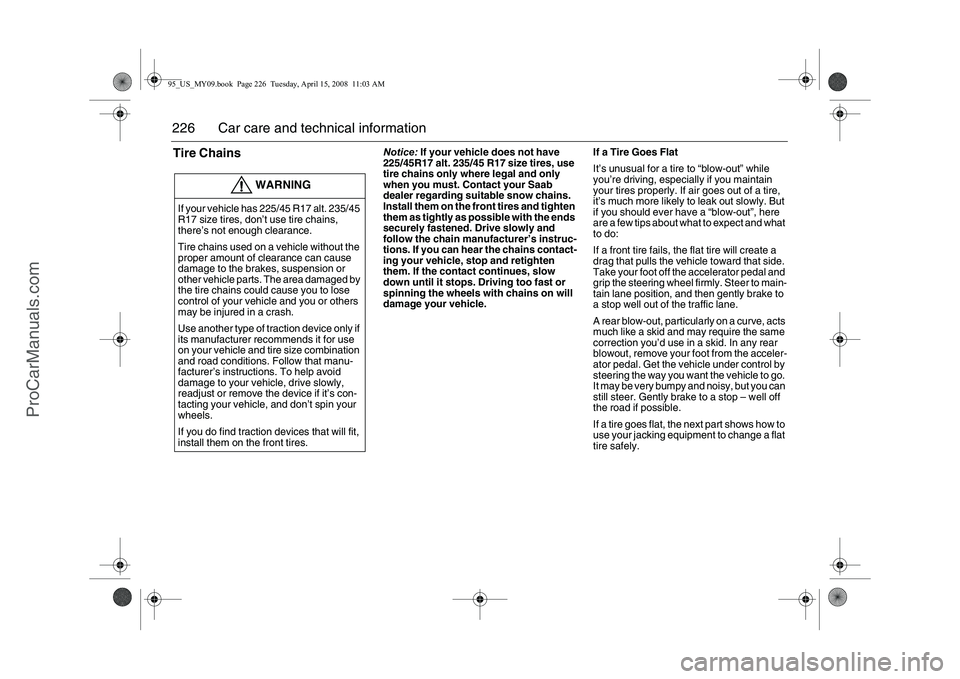
226 Car care and technical informationTire Chains
Notice: If your vehicle does not have
225/45R17 alt. 235/45 R17 size tires, use
tire chains only where legal and only
when you must. Contact your Saab
dealer regarding suitable snow chains.
Install them on the front tires and tighten
them as tightly as possible with the ends
securely fastened. Drive slowly and
follow the chain manufacturer’s instruc-
tions. If you can hear the chains contact-
ing your vehicle, stop and retighten
them. If the contact continues, slow
down until it stops. Driving too fast or
spinning the wheels with chains on will
damage your vehicle.If a Tire Goes Flat
It’s unusual for a tire to “blow-out” while
you’re driving, especially if you maintain
your tires properly. If air goes out of a tire,
it’s much more likely to leak out slowly. But
if you should ever have a “blow-out”, here
are a few tips about what to expect and what
to do:
If a front tire fails, the flat tire will create a
drag that pulls the vehicle toward that side.
Take your foot off the accelerator pedal and
grip the steering wheel firmly. Steer to main-
tain lane position, and then gently brake to
a stop well out of the traffic lane.
A rear blow-out, particularly on a curve, acts
much like a skid and may require the same
correction you’d use in a skid. In any rear
blowout, remove your foot from the acceler-
ator pedal. Get the vehicle under control by
steering the way you want the vehicle to go.
It may be very bumpy and noisy, but you can
still steer. Gently brake to a stop – well off
the road if possible.
If a tire goes flat, the next part shows how to
use your jacking equipment to change a flat
tire safely.
WARNING
If your vehicle has 225/45 R17 alt. 235/45
R17 size tires, don’t use tire chains,
there’s not enough clearance.
Tire chains used on a vehicle without the
proper amount of clearance can cause
damage to the brakes, suspension or
other vehicle parts. The area damaged by
the tire chains could cause you to lose
control of your vehicle and you or others
may be injured in a crash.
Use another type of traction device only if
its manufacturer recommends it for use
on your vehicle and tire size combination
and road conditions. Follow that manu-
facturer’s instructions. To help avoid
damage to your vehicle, drive slowly,
readjust or remove the device if it’s con-
tacting your vehicle, and don’t spin your
wheels.
If you do find traction devices that will fit,
install them on the front tires.95_US_MY09.book Page 226 Tuesday, April 15, 2008 11:03 AM
ProCarManuals.com
Page 228 of 272

228 Car care and technical informationAspect ratio: A two-digit number that indi-
cates the tire height-to-width measure-
ments. For example, if the tire size aspect
ratio is “55”, as shown in item “C” of the illus-
tration, it would mean that the tire´s sidewall
is 55% as high as it is wide.
Belt Rating: A letter code is used to indicate
the type of ply construction in the tire. The
letter “R” means radial ply construction; the
letter “D” means diagonal or bias ply con-
struction; and the letter “B” means
belted-bias ply construction.
Rim Diameter: Diameter of the wheel in
inches.
Load range: The load range represents the
load carry capacity a tire is certified to carry.
Speed Rating: The maximum speed that a
tire is certified to carry a load. Speed ratings
range from “A” to “Z”.
Tire markingsAn example of the meaning of the different
markings in a tire size is given below for a
tire size of:
215/55 R16 93 V 215 Tire section width, mm
55Aspect ratio, i.e. the section height
is 55 % of the section width
R Radial ply
16Wheel rim diameter 16 in at bead
seats
93 Tire load code
V Speed marking
Tire load index
91Tire approved for max. 1355 lbs.
(615 kg)
93 Max. 1433 lbs (650 kg)
94 Max. 1477 lbs (670 kg)
Speed ratings
QTire approved for speeds up to
100 mph (160 km/h)
S Max. 112 mph (180 km/h)
T Max. 118 mph (190 km/h)
H Max. 130 mph (210 km/h)
V Max. 150 mph (240 km/h)
W Max. 167 mph (270 km/h)
Y Max. 186 mph (300 km/h)
TIN-codea Manufacturer´s Identification Mark
b Tire Size
c Tire Type Code
d Date of Manufacture
95_US_MY09.book Page 228 Tuesday, April 15, 2008 11:03 AM
ProCarManuals.com
Page 231 of 272
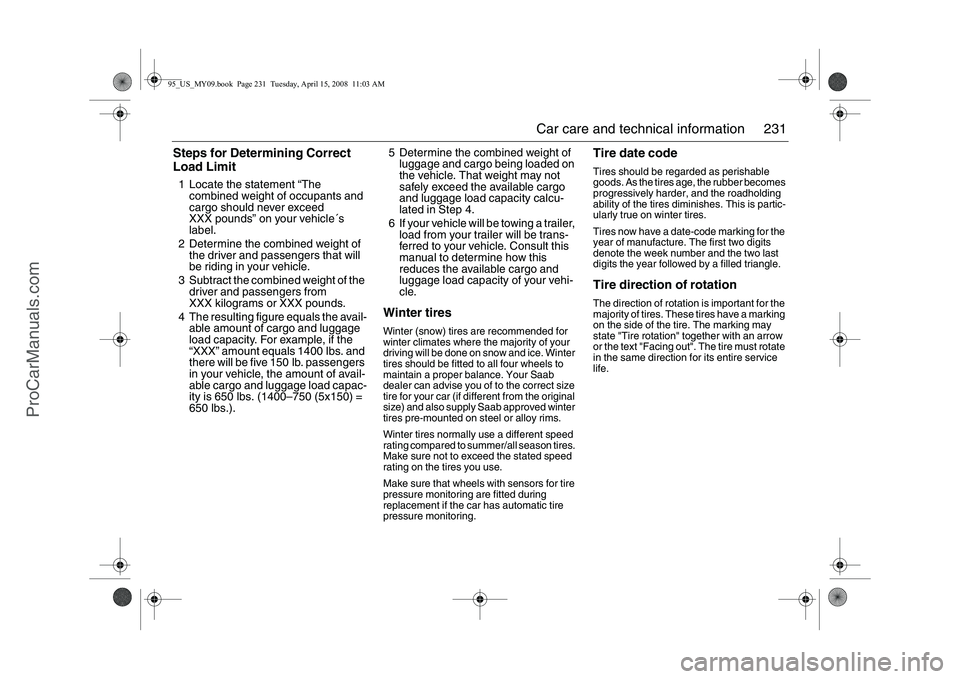
231 Car care and technical information
Steps for Determining Correct
Load Limit1 Locate the statement “The
combined weight of occupants and
cargo should never exceed
XXX pounds” on your vehicle´s
label.
2 Determine the combined weight of
the driver and passengers that will
be riding in your vehicle.
3 Subtract the combined weight of the
driver and passengers from
XXX kilograms or XXX pounds.
4 The resulting figure equals the avail-
able amount of cargo and luggage
load capacity. For example, if the
“XXX” amount equals 1400 lbs. and
there will be five 150 lb. passengers
in your vehicle, the amount of avail-
able cargo and luggage load capac-
ity is 650 lbs. (1400–750 (5x150) =
650 lbs.).5 Determine the combined weight of
luggage and cargo being loaded on
the vehicle. That weight may not
safely exceed the available cargo
and luggage load capacity calcu-
lated in Step 4.
6 If your vehicle will be towing a trailer,
load from your trailer will be trans-
ferred to your vehicle. Consult this
manual to determine how this
reduces the available cargo and
luggage load capacity of your vehi-
cle.
Winter tiresWinter (snow) tires are recommended for
winter climates where the majority of your
driving will be done on snow and ice. Winter
tires should be fitted to all four wheels to
maintain a proper balance. Your Saab
dealer can advise you of to the correct size
tire for your car (if different from the original
size) and also supply Saab approved winter
tires pre-mounted on steel or alloy rims.
Winter tires normally use a different speed
rating compared to summer/all season tires.
Make sure not to exceed the stated speed
rating on the tires you use.
Make sure that wheels with sensors for tire
pressure monitoring are fitted during
replacement if the car has automatic tire
pressure monitoring.
Tire date codeTires should be regarded as perishable
goods. As the tires age, the rubber becomes
progressively harder, and the roadholding
ability of the tires diminishes. This is partic-
ularly true on winter tires.
Tires now have a date-code marking for the
year of manufacture. The first two digits
denote the week number and the two last
digits the year followed by a filled triangle.Tire direction of rotationThe direction of rotation is important for the
majority of tires. These tires have a marking
on the side of the tire. The marking may
state "Tire rotation" together with an arrow
or the text "Facing out". The tire must rotate
in the same direction for its entire service
life.
95_US_MY09.book Page 231 Tuesday, April 15, 2008 11:03 AM
ProCarManuals.com
Page 258 of 272

258 SpecificationsGeneral Overall length, including bumpers:
9-5 Sedan _______________________ 190.4 in (4836 mm)
9-5 SportCombi __________________ 190.6 in (4841 mm)
Overall width, including door mirrors ____ 80.4 in (2042 mm)
Maximum height:
9-5 Sedan _______________________ 57.3 in (1454 mm)
9-5 SportCombi __________________ 57.7 in (1465 mm)
Wheelbase _______________________ 106.4 in (2703 mm)
Ground clearance at gross vehicle weight approx. 4.6 in
(116 mm)
Tr a c k :
Front __________________________ 59.9 in (1522 mm) *)
Rear ___________________________ 60.2 in (1528 mm) *)
Turning circle (curb to curb) ___________ 37.1 ft (11.3 m)
Turning circle (measured at vehicle extremi-
ties) _____________________________ 39.0 ft (11.9 m)
Number of seats (incl. driver) _________ 5
*) Specified track applies to wheel sizes: 6.5 x 16
VIN on cars sold in
USAVIN on cars sold in CanadaPermissible load (in addition to driver) = GVW minus curb weight
The maximum permissible axle load, front or rear, must not be exceeded.
The maximum permissible axle load, front or rear, must not be exceeded. Chassis number in engine bay
Weight ready for driving (i.e. with full fuel
tank, washer-fluid reservoir, standard tools
and spare wheel) ____________________ 3450–3760 lbs.
(1565–1705 kg)
Gross vehicle weight (GVW) ___________ 4390–4700 lbs.
(1990–2130 kg)
Maximum axle load:
Front ___________________________ 2590 lbs. (1175 kg)
Rear, 9-5 Sedan ___________________ 2310 lbs. (1050 kg)
Rear, 9-5 SportCombi ______________ 2480 lbs. (1125 kg)
Weight distribution:
Curb weight, front/rear ______________ 60/40 %
GVW, front/rear ___________________ 50/50 %
Maximum roof load __________________ 220 lbs. (100 kg)
Maximum luggage compartment load§ ___ 176 lbs. (80 kg)
Maximum combined load, luggage
compartment and roof ________________ 264 lbs. (120 kg)
95_US_MY09.book Page 258 Tuesday, April 15, 2008 11:03 AM
ProCarManuals.com
Page 261 of 272

261 Specifications
Wheels and tires(recommended dimensions)
2.3 Turbo
All season tires
215/55 R16 93 H X
235/45 R17 94 V X
Winter tires
215/55 R16 93 Q X
225/45 R17 94 Q XL/RF X
235/45 R17 94 Q X
Wheel sizes
6.5 x 16” X
7 x 17” X
7.5 x 17” X
Before changing to wheels/tires of another size, we recommend
that you contact an authorized Saab dealer regarding acceptable
options.
Speed ratings and load indexes, see page 228.
Compact spare:
Wheel ___________________________ 4 x 16”
Tire _____________________________ T115/70 R16
Pressure_________________________ 60 psi (420 kPa)
Maximum life _____________________ 2,200 miles
(3500 km)
Maximum speed __________________ 50 mph (80 km/h)
95_US_MY09.book Page 261 Tuesday, April 15, 2008 11:03 AM
ProCarManuals.com
Page 262 of 272
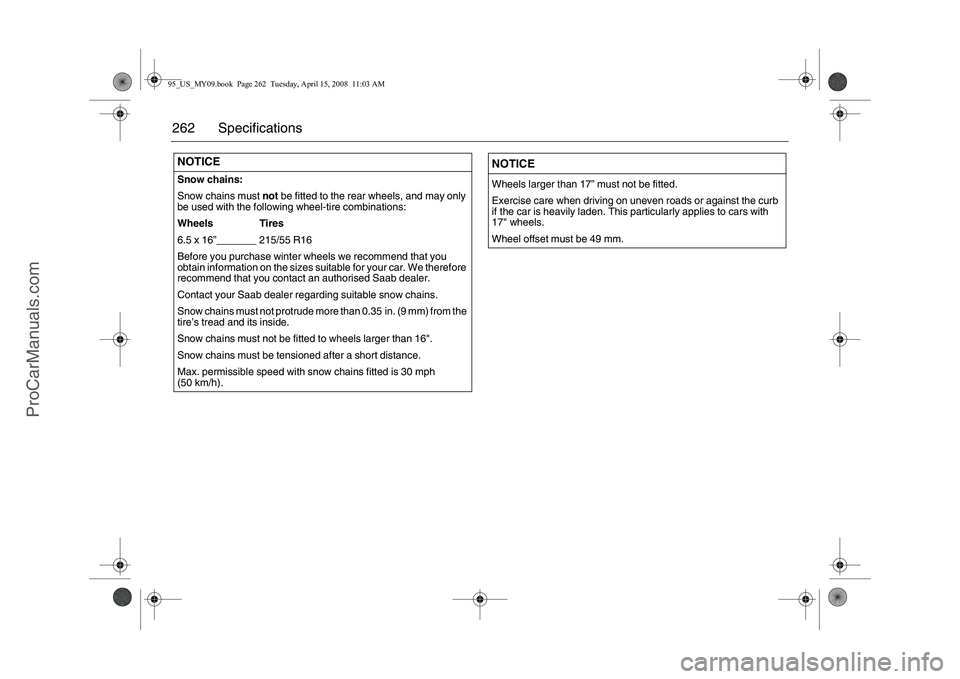
262 SpecificationsNOTICESnow chains:
Snow chains must not be fitted to the rear wheels, and may only
be used with the following wheel-tire combinations:
Wheels Tires
6.5 x 16”_______ 215/55 R16
Before you purchase winter wheels we recommend that you
obtain information on the sizes suitable for your car. We therefore
recommend that you contact an authorised Saab dealer.
Contact your Saab dealer regarding suitable snow chains.
Snow chains must not protrude more than 0.35 in. (9 mm) from the
tire’s tread and its inside.
Snow chains must not be fitted to wheels larger than 16".
Snow chains must be tensioned after a short distance.
Max. permissible speed with snow chains fitted is 30 mph
(50 km/h).
NOTICEWheels larger than 17” must not be fitted.
Exercise care when driving on uneven roads or against the curb
if the car is heavily laden. This particularly applies to cars with
17" wheels.
Wheel offset must be 49 mm.
95_US_MY09.book Page 262 Tuesday, April 15, 2008 11:03 AM
ProCarManuals.com
Page 263 of 272
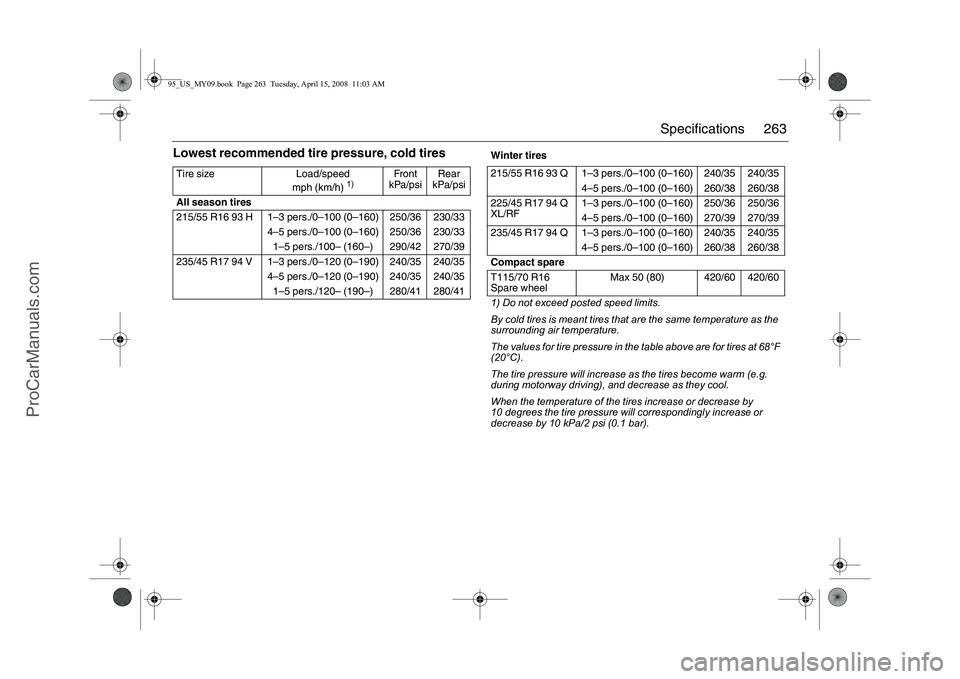
263 Specifications
Lowest recommended tire pressure, cold tiresTire size Load/speed
mph (km/h)
1)
Front
kPa/psiRear
kPa/psi
All season tires
215/55 R16 93 H 1–3 pers./0–100 (0–160) 250/36 230/33
4–5 pers./0–100 (0–160) 250/36 230/33
1–5 pers./100– (160–) 290/42 270/39
235/45 R17 94 V 1–3 pers./0–120 (0–190) 240/35 240/35
4–5 pers./0–120 (0–190) 240/35 240/35
1–5 pers./120– (190–) 280/41 280/41
Winter tires
215/55 R16 93 Q 1–3 pers./0–100 (0–160) 240/35 240/35
4–5 pers./0–100 (0–160) 260/38 260/38
225/45 R17 94 Q
XL/RF1–3 pers./0–100 (0–160) 250/36 250/36
4–5 pers./0–100 (0–160) 270/39 270/39
235/45 R17 94 Q 1–3 pers./0–100 (0–160) 240/35 240/35
4–5 pers./0–100 (0–160) 260/38 260/38
Compact spare
T115/70 R16
Spare wheelMax 50 (80) 420/60 420/60
1) Do not exceed posted speed limits.
By cold tires is meant tires that are the same temperature as the
surrounding air temperature.
The values for tire pressure in the table above are for tires at 68°F
(20°C).
The tire pressure will increase as the tires become warm (e.g.
during motorway driving), and decrease as they cool.
When the temperature of the tires increase or decrease by
10 degrees the tire pressure will correspondingly increase or
decrease by 10 kPa/2 psi (0.1 bar).
95_US_MY09.book Page 263 Tuesday, April 15, 2008 11:03 AM
ProCarManuals.com
Page 271 of 272
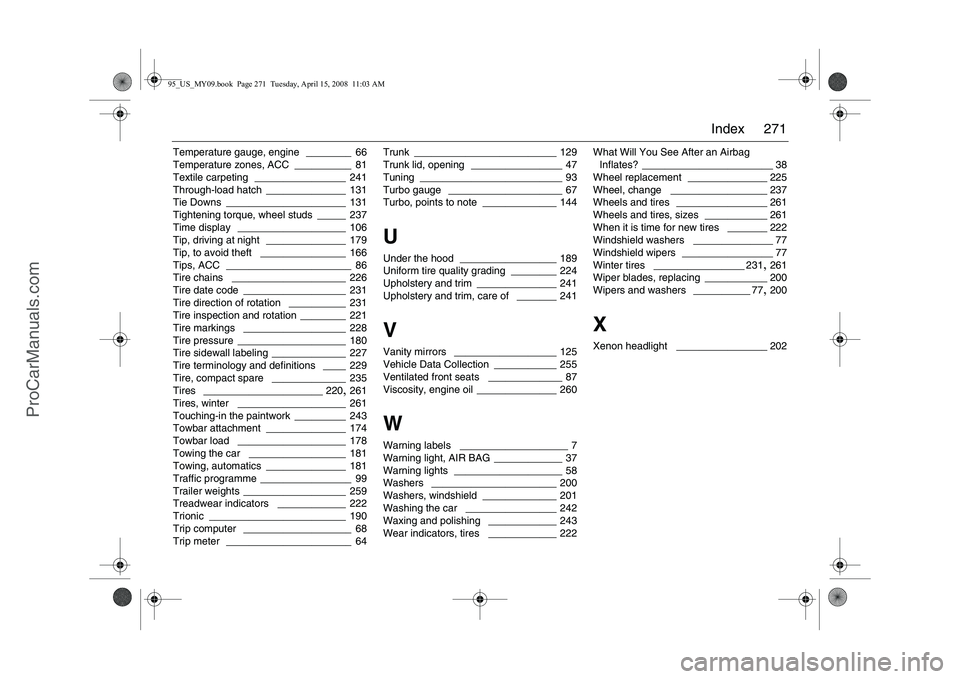
271 Index
Temperature gauge, engine
________ 66
Temperature zones, ACC
__________ 81
Textile carpeting
________________ 241
Through-load hatch ______________ 131
Tie Downs
_____________________ 131
Tightening torque, wheel studs
_____ 237
Time display
___________________ 106
Tip, driving at night
______________ 179
Tip, to avoid theft
_______________ 166
Tips, ACC
______________________ 86
Tire chains ____________________ 226
Tire date code __________________ 231
Tire direction of rotation
__________ 231
Tire inspection and rotation ________ 221
Tire markings
__________________ 228
Tire pressure ___________________ 180
Tire sidewall labeling
_____________ 227
Tire terminology and definitions
____ 229
Tire, compact spare
_____________ 235
Tires
_____________________ 220
, 261
Tires, winter
___________________ 261
Touching-in the paintwork
_________ 243
Towbar attachment
______________ 174
Towbar load
___________________ 178
Towing the car _________________ 181
Towing, automatics
______________ 181
Traffic programme ________________ 99
Trailer weights
__________________ 259
Treadwear indicators
____________ 222
Trionic
________________________ 190
Trip computer
___________________ 68
Trip meter
______________________ 64Trunk
_________________________ 129
Trunk lid, opening
________________ 47
Tuning
_________________________ 93
Turbo gauge
____________________ 67
Turbo, points to note
_____________ 144
UUnder the hood
_________________ 189
Uniform tire quality grading
________ 224
Upholstery and trim
______________ 241
Upholstery and trim, care of
_______ 241
VVanity mirrors
__________________ 125
Vehicle Data Collection
___________ 255
Ventilated front seats
_____________ 87
Viscosity, engine oil
______________ 260
WWarning labels
___________________ 7
Warning light, AIR BAG
____________ 37
Warning lights
___________________ 58
Washers
______________________ 200
Washers, windshield
_____________ 201
Washing the car
________________ 242
Waxing and polishing
____________ 243
Wear indicators, tires ____________ 222What Will You See After an Airbag
Inflates?
_______________________ 38
Wheel replacement
______________ 225
Wheel, change
_________________ 237
Wheels and tires ________________ 261
Wheels and tires, sizes
___________ 261
When it is time for new tires
_______ 222
Windshield washers
______________ 77
Windshield wipers
________________ 77
Winter tires
________________ 231
, 261
Wiper blades, replacing
___________ 200
Wipers and washers
__________ 77
, 200
XXenon headlight
________________ 202
95_US_MY09.book Page 271 Tuesday, April 15, 2008 11:03 AM
ProCarManuals.com